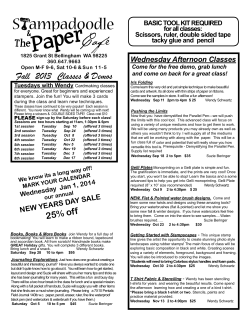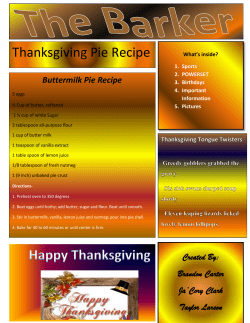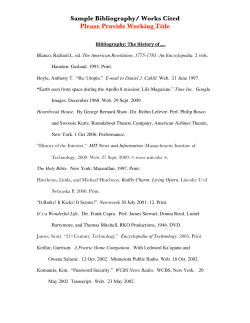
LOS ANGELES MISSION COLLEGE–FALL 2009 CHEMISTRY 52–SEC. 3062 Lecture: MW 6:05–7:30 Room INST–2014 Laboratory: MW 7:40 – 9:05 Room: INST –2014
LOS ANGELES MISSION COLLEGE–FALL 2009 CHEMISTRY 52–SEC. 3062 Lecture: MW 6:05–7:30 Room INST–2014 Laboratory: MW 7:40 – 9:05 Room: INST –2014 INSTRUCTOR: Said Pazirandeh EMAIL: profpaz@earthlink.net WEBSITE: www.profpaz.com OFFICE PHONE: (818) 3647705 OFFICE HOURS: MW 4:30–5:45 TTh 4:305:15 CLASS Chem 52 is the second semester of introductory class in general chemistry and is designed for DESCRIPTION: students in the following majors: Nursing, Allied Health Sciences; Dietetics, Physical Therapy, Food Science & Environmental & Occupational Health. Chemistry 52 at LA Mission College is equivalent to Chemistry 104 at CSUN. PREREQUISITE: Chemistry 51 or 65 with a grade of “C” or better. REQUIRED 1. Textbook: ““General, Organic, and Biological Chemistry”, by Timberlake, 2 nd Edition, MATERIALS: Custom Published for LA Mission College.. Available in the LAMC Bookstore. 2. Lab Notebook: This is a quadrille paper, hard cover “Comp Book”, available in the LAMC Bookstore and general office supply stores. You must have the Laboratory Notebook by the third class meeting.You are required to report all laboratory work in your Laboratory Notebook (See Appendix II for the proper use of the Laboratory Notebook)During the Laboratory Activities you are not permitted to take notes on any kind of loose paper or any notebook, other than the Laboratory Notebook. You may not perform an experiment if you do not have your Laboratory Notebook with you. 3. Periodic Table of Elements: This is available on my website. You must have one Periodic Table with you during all class sessions. 4. Scientific Calculator: Need not to be an expensive type, but it must perform the following operations: Multiplication, Division, Addition, Subtraction, Square root, 1/x, and Logarithm. You are required to have your calculator with you during all class sessions (both lectures and labs). 5. Safety Goggles: Unless specifically instructed otherwise by your instructor, you must wear safety goggles during laboratory work. Safety goggles are available in the LAMC Bookstore. You are required to have your safety goggles by the 2 nd week of class. Loaner goggles are available in the lab if y ou choose not to purchase goggles yourself. 6. Notebook: A 3ring binder is recommended for keeping class notes organized. ATTENDANCE: · CHEMISTRY IS A DEMANDING SUBJECT! · THERE IS NO MAKEUP LABORATORY WORK. · YOU CANNOT AFFORD TO BE ABSENT IF YOU WANT TO DO WELL IN THIS CLASS. · College regulations state that a student may be excluded from a course following accumulation absences equal to a week of course work. 1 STUDENT LEARNING OUTCOMES: 1. Conceptualize, model and explain chemical processes qualitatively at the molecular level. 2. Apply mathematics to solve quantitative chemical problems. 3. Extract appropriate information, analyze and synthesize experimental results to reach correct conclusions. 4. Perform laboratory techniques safely and accurately and maintain a laboratory notebook according to standard scientific guidelines. COURSE Your final grade in class is composed of the following: EVALUTATION: Quizzes (10) Exams (3) Final Exam 1 st Lab Exam 2 nd Lab Exam Final Lab Exam Lab Reports . Total 100 points 300 points 150 points 50 points 50 points 100 points 250 points . 1000 points GRADING The final grades cutoffs are as follows: SCALE: A B C D F NOTES: 90% 100% 80% 90% 65% 80% 55% 65% Below 55% · No makeup exams are given for students being absent on the day of the exam. · If serious and compelling reasons prevent the student from being present on the day of one of the exam, the instructor should be informed IN ADVANCE for possible arrangements. · Makeup exams are limited to one per semester. 2 TENTATIVE LECTURE OUTLINE Week 1 2 3 4 5 6 7 8 9 10 11 12 13 14 15 16 Date Aug. 31 Sep. 2 Sep. 7 Sep. 9 Sep. 14 Sep. 16 Sep. 21 Sep. 23 Sep. 28 Sep. 30 Oct. 5 Oct. 7 Oct. 12 Oct. 14 Oct. 19 Oct. 21 Oct. 26 Oct. 28 Nov. 2 Nov. 4 Nov. 9 Nov. 11 Nov. 16 Nov. 18 Nov. 23 Nov. 25 Nov. 30 Dec. 2 Dec. 7 Dec. 9 Dec. 16 5:30–7:30 Notes Chap. 14 14 14 15 15 15 15 16 16 16 16 16 Description 17 17 18 18 19 19 20 20 22 26 Introduction to Class / Solutions Units of Concentration Labor Day (College closed) Colligative Properties Acids, Bases & Salts pH Calculations pH Calculations (cont’d) Reactions of Acids & Bases Review for Test 1 Test 1 (Chapters 14–15) Chemical Equilibrium Let Chaterlier’s Principle Equilibrium Constant Hydrolysis / Buffers Hydrolysis / Buffers (cont’d) Review for Test 2 Test 2 (Chapter 16) Oxidation – Reduction Activity Series of Metals Nuclear Decay Nuclear Reactions Veteran’s Day (College closed) Test 3 (Chapters 17–18) Introduction to Organic Chemistry Saturated Hydrocarbons Unsaturated Hydrocarbons Reactions of Alkenes; Aromatic Compounds Alcohols, Ethers, Phenols Stereoisomers Review for Final Exam Final Exam (Chapters 19 – 26) 3 Test Reference 8.18.3 8.48.5 8.6 10.110.3 10.410.5 10.6 9.19.2 9.5 9.39.4 10.710.8 5.4 3.13.2 3.43.6 11.1, 11.5 11.211.4 12.112.2 12.312.6 13.113.4 14 LABORATORY WORK · · · · · · · · · During laboratory work two students will share the contents of the same laboratory locker. Both students are jointly responsible for the contents of their shared locker. The majority (not all) of the experiments are performed in pairs. For every experiment, each student, 1. will take active part in the work, 2. report his/her data individually, 3. do his/her own calculations, 4. turn in an individual lab report for grading purposes and 5. will be assigned an individual grade for every activity. Laboratory Reports are due one week after the class period in which the experiments have been performed (this is to allow working students to meet the deadline). Late reports are subject to a penalty of 10% per week. Once the instructor has returned the graded lab reports to the class, lab reports for that particular experiment are no longer accepted for grading. In order to work efficiently and meet the required deadline for turning in the lab reports, you must come to the laboratory well prepared. This means: 1. Read carefully (several times, if needed) the Experiment you will perform (both Principles and Procedure) prior to coming to the lab. 2. Think about what will be doing and plan ahead. 3. Prepare your Laboratory Notebook in advance (Purpose of the Experiment and the appropriate Data Tables may be prepared in your Laboratory Notebook in advance). THERE IS NO MAKEUP LABORATORY WORK INSTRUCTIONS FOR LABORATORY NOTEBOOK · Each student must have a quadrille ruled, sewn Laboratory Notebook in which to record data and observations, do calculations, and analyze results of the lab work. · The Lab Notebook must be brought with you to every lab session and all data and observations must be recorded directly into the Notebook (nowhere else) and in ink (no pencil). Laboratory records are legal documents in industry and research. They are required to support patent applications or to resolve disputes or originality of research . · You will write only on the right hand pages. The lefthand pages are reserved for calculations and notes that do not belong on the right hand page. · Begin with a TITLE PAGE State the course, section number, semester, the instructor’s name, your name and your locker number. · The second page is an INDEX. As you do each experiment, list it by title and enter the numbers of the pages containing text for it. Leave a second page for continuation of the Index. At the bottom of the second index page, give the complete bibliographic information for the laboratory text used. (Title, author, publisher, date.) When you do this you can cite a reference simply by “Text”; otherwise you must cite the complete reference each time. · The remainder of the righthand pages in the Notebook should be numbered sequentially in the upper right corner of the page. 4 The FORMAT of the pages for each lab experiment is as follows: _________________________________________________________________________________ TITLE: Here you enter the title of experiment. Page Number PURPOSE: PROCEDURE: Write a short statement (one or two sentences, in your own words) of the purpose or the goal of the experiment. Cite a reference to the appropriate text(s). Any changes made by the instructor may be noted on the lefthand side of the page. DATA/OBSERVATIONS: Prepare a data table in which you will record the measurements you make in the lab. The lab Report Form often will provide a good format, but it is wise to check with the instructor about the amount of space to be allowed when observations, rather than measurements, are to be recorded. Be careful to indicate units wherever appropriate. RESULTS: This presents, in table form, the final answers to any required calculations. All work (i.e., setups for all calculations) must be shown on the lefthand page. CONCLUSIONS: Essentially, your conclusions should answer the Purpose or the Goal of the Experiment. Write a few words of conclusion, indicating any experimental errors and their effects on your results. Also state whether or not you achieved the purpose of the experiment. _____________________________________________________________________________________ · As you work, enter your Data/Observations in ink. If you make an error or repeat an exercise, DO NOT ERASE ANYTHING. You may draw a line through the offending information and then enter the new value (It may be necessary to do this on the lefthand page, if there is no room on the right hand page.) · If the entire page is in error, simply draw a diagonal line through the page and fold the page in half vertically. · NEVER, NEVER, TEAR OUT A PAGE (other pages will fall out as well). · BE PREPARED TO SHOW YOUR NOTEBOOK TO YOUR INSTRUCTOR AT ANY TIME! · Additional Information about the proper usage of the Laboratory Notebook is found in Appendix II of the Laboratory Manual used for this course (“Everyday Chemistry” by Maria Fenyes, Los Angeles Mission College, Fall 96) 5 TENTATIVE LABORATORY SCHEDULE Week 1 2 3 4 5 6 7 8 9 10 11 12 13 14 15 Date Aug. 31 Sep. 2 Sep. 7 Sep. 9 Sep. 14 Sep. 16 Sep. 21 Sep. 23 Sep. 28 Sep. 30 Oct. 5 Exp. # 1 1 2 3 3 4 5 Oct. 7 Oct. 12 Oct. 14 Oct. 19 Oct. 21 Oct. 26 Oct. 28 Nov. 2 6 7 7 8 8 9 9 Nov. 4 Nov. 9 Nov. 11 Nov. 16 Nov. 18 Nov. 23 Nov. 25 Nov. 30 Dec. 2 Dec. 7 10 10 10 11 12 12 13 14 Dec. 9 Title Introduction to Lab/Safety Video Checkin Labor Day (College closed) Freezing Point Depression Freezing Point Depression (cont’d) Acids, Bases pH Calculations pH Calculations (cont’d) Standardization of a Base Analysis of Vinegar Complete experiments 4 & 5 First Lab Exam ( Exp. 13) (You may use your lab notebook) Equilibrium Game Equilibrium Systems Equilibrium Systems (cont’d) Hydrolysis of Salts Hydrolysis of Salts (cont’d) Buffers Buffers (cont’d) Second Lab Exam (Exp. 47) (You may use your lab notebook) Activity Series Veteran’s Day (College closed) Activity Series (cont’d) Nuclear Decay (Computer Lab) Structure of Alkanes Structure of Alkanes (cont’d) Structural Isomers Stereoisomers Checkout Final Lab Exam (Remaining Exps.) (You may use your lab notebook) 6
© Copyright 2025











